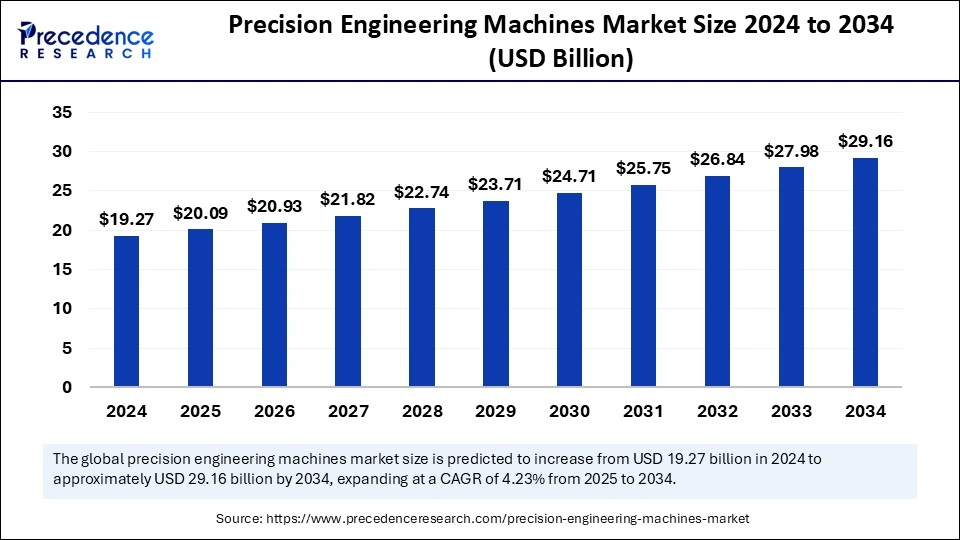
Precision Engineering Machines Market Key Takeaways
- Asia pacific dominated global market with largest market share of 34% in 2024.
- Europe is expected to witness the fastest growth in the coming years.
- By application, the automotive segment accounted for the biggest market share in 2024.
- By application, the industrial machinery segment is expected to witness the fastest growth in the foreseeable period.
- By product type, the CNC machines segment contributed the highest market share in 2024.
- By product type, the 3D printers segment is projected to grow at the fastest CAGR during the forecast period.
Precision Engineering Machines Market Overview
The Precision Engineering Machines Market catering to aerospace and defense industries has grown significantly due to the sector’s increasing need for components with tight tolerances, complex geometries, and high-performance materials. These machines—such as multi-axis CNC machines, precision lathes, and EDM systems—are crucial for manufacturing engine components, turbine blades, structural elements, and aerospace-grade fasteners. As defense budgets rise and demand for next-generation aircraft increases, the need for ultra-precise, reliable, and repeatable machining systems has intensified.
Precision Engineering Machines Market Drivers
A major driver in this segment is the constant push for weight reduction and improved fuel efficiency in aircraft, which requires the use of lightweight materials like titanium and composites. These materials demand specialized precision machinery for effective processing. The aerospace sector’s stringent safety and quality standards further necessitate machines that offer micron-level accuracy and repeatability.
Additionally, global defense modernization programs are boosting the production of advanced military equipment, thereby fueling demand for high-performance precision machines.
Rising Demand for High-Precision Components
One of the major factors driving the growth of the precision engineering machines market is the increasing demand for highly accurate components in various end-use industries like aerospace, defense, medical devices, electronics, semiconductors, and automotive. These industries are increasingly seeking high-tolerance components as a smaller deviation can significantly change the overall performance of a system.
Aircraft components such as gear parts for landing and turbine blades require highly accurate machining for safety purposes and seamless functioning. The increasing defense investments by many governments across the globe to ensure national-level safety further boosts the demand for precision engineering machines.
The rising demand for compact and high-performance electronic devices is another driver for the market. Systems like circuit board manufacturing, microelectromechanical systems, and wafer fabrication in the semiconductor industry require extreme precision, which can be achieved by precision engineering machines, making them an essential part of these ever-evolving industries.
Precision Engineering Machines Market Opportunities
There is a significant opportunity in the integration of advanced digital technologies like AI, IoT, and predictive analytics into precision engineering machines. These capabilities enable real-time monitoring, predictive maintenance, and optimization, which are highly valuable in aerospace manufacturing.
Additionally, the trend toward electric and autonomous aircraft is creating new demand for custom components, opening avenues for niche precision machine offerings.
Precision Engineering Machines Market Challenges
One of the key challenges in this segment is the high capital investment required to procure and maintain advanced precision engineering machines. Skilled labor shortages in aerospace manufacturing can also hinder efficient machine operation and output.
Moreover, maintaining consistent precision in high-mix, low-volume production environments, common in aerospace, can strain machine productivity and quality assurance systems.
Precision Engineering Machines Market Regional Insights
North America, particularly the United States, leads this market segment due to its robust aerospace and defense manufacturing infrastructure. Europe follows closely with established aerospace clusters in countries like Germany, France, and the UK. The Asia-Pacific region is emerging rapidly, led by growing aerospace investments in China, India, and Japan.
Precision Engineering Machines Market Recent Developments
Recent trends include the adoption of hybrid precision machines that combine additive and subtractive processes for rapid prototyping and complex part production. Companies are also developing high-speed, vibration-dampened spindles to accommodate difficult-to-machine aerospace alloys.
Additionally, leading manufacturers have begun offering turnkey precision machining solutions with integrated automation and digital twin technologies.
Precision Engineering Machines Market Companies
- Amada Machine Tools Co., Ltd.
- Amera-Seiki
- DATRON AG
- Dalian Machine Tool Group (DMTG) Corporation
- DMG Mori Co., Ltd.
- FANUC Corporation
- Haas Automation, Inc.
- Hurco Companies, Inc.
- Okuma Corporation
- Shenyang Machine Tool Co., Ltd.
- Yamazaki Mazak Corporation
Segments covered in the report
By Application
- Automotive
- Aerospace
- Medical Devices
- Consumer Electronics
- Industrial Machinery
By Product Type
- CNC Machines
- Laser Cutting Machines
- 3D Printers
- Electrical Discharge Machines
- Grinding Machines
By Region
- North America
- Europe
- Asia Pacific
- Latin America
- Middle East and Africa (MEA)
Ready for more? Dive into the full experience on our website!
